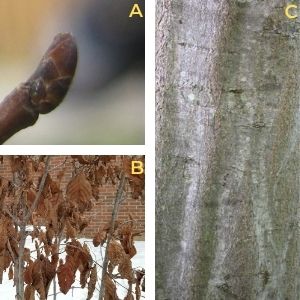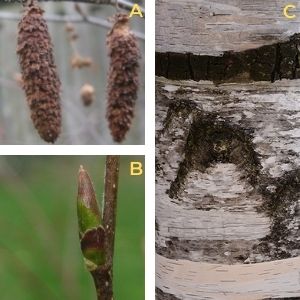When identifying a tree, you should never rely on one characteristic. A good detective looks at all the clues and, when it comes to trees, clues can be in the form of leaves, bark, growth form, fruit, flowers, cones, buds, twigs and growing site. Here’s how to identify four different native deciduous trees this winter.

How can you spot this Carolinian species in the winter? Look at its bark, fruit and buds!
A -The tulip tree’s bark has dark grey ridges and white furrows that form a diamond-shaped pattern.
B - The flower-like fruit of this tree begins to drop in fall but can sometimes be seen on the tree in early winter. The dried fruit is made up of long seeds called samaras, which blow-off in the wind leaving behind an upright central stock on the branch tips.
C -The terminal bud (at the end of the twig) is flat, duckbill-shaped and 12 to 14 mm long, while the lateral buds (other buds along the twig) are much smaller by comparison.

Don’t be fooled by the name! This species actually belongs to the birch family and can be identified in the winter by its buds, leaves and bark.
A -The buds are small (approximately three mm long), ovoid in shape, often slightly hairy and are reddish-brown in colour with whitish margins.
B - This tree is marcescent, which means it holds onto its dead leaves throughout the winter time. You can identify the blue beech leaves by their simple, elliptical leaves and serrated edges. Other marcescent species include oaks, beeches and witch-hazel.
C -The bark is the reason for the blue beech’s other name: musclewood. It’s smooth, slate-gray with muscle-like longitudinal ridges.
Tip: having trouble distinguishing the blue beech from American or European beech? Check the buds! The blue beech has small, ovoid buds that are pressed against the twig while the American and European beech have long buds that point away from the twig.

Three features to look out for when identifying this species in the winter are its fruit, bud and bark.
A -The seed catkin (fruit) of the paper birch is made up of tiny seeds called nutlets. The nutlets begin to shed from the catkin in fall and leave behind a bare axis (stem) that stays on the branch during the winter.
B - The slender buds are five to seven mm in length, greenish toward the base and brown toward the tip.
C - The paper birch has creamy white bark, which peels off into papery strips, and horizontal black marks.

The Ohio buckeye can be recognized by its buds, bark and leaf scars.
A - The buds of this species have reddish, triangular scales. The terminal bud is large (15 to 18 mm long) and pointed while the lateral buds are smaller and paired across from each other.
B - The bark is grey, rough, corky and scaly.
C - When a leaf falls off a tree, it leaves behind a scar where it was once attached. The leaf scar of an Ohio buckeye has a distinct horseshoe shape.
Tip: Having trouble distinguishing the Ohio buckeye from the closely related horsechestnut? Check the terminal buds! The terminal bud on the horsechestnut is sticky and larger than the non-sticky terminal bud of the Ohio buckeye.
Want to add these beautiful native species to your property? We offer these and more through our subsidized Backyard Tree Planting Program. We accept applicants year-round and are already processing applications for our spring planting and delivery season.
Jess Wilkin is the Residential Planting Programs Operations Coordinator. She holds a Master’s of Forest Conservation from the University of Toronto.
LEAF offers a subsidized Backyard Tree Planting Program for private property. The program is supported by the City of Toronto, the Regional Municipality of York, the City of Markham, the Town of Newmarket, the Town of Ajax, the Regional Municipality of Durham, the Township of Scugog, the City of Pickering, the City of Oshawa, the Town of Whitby and Ontario Power Generation.
